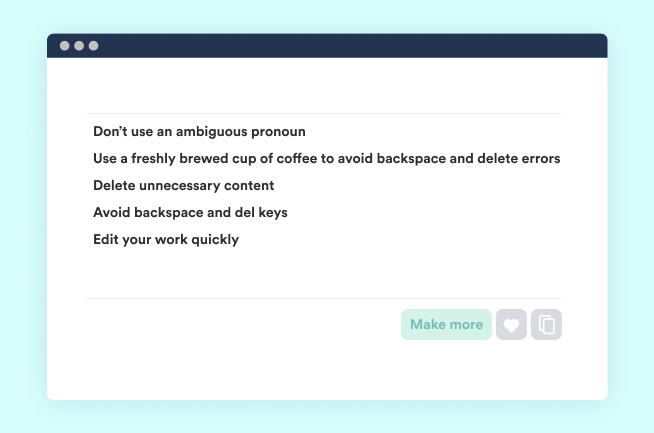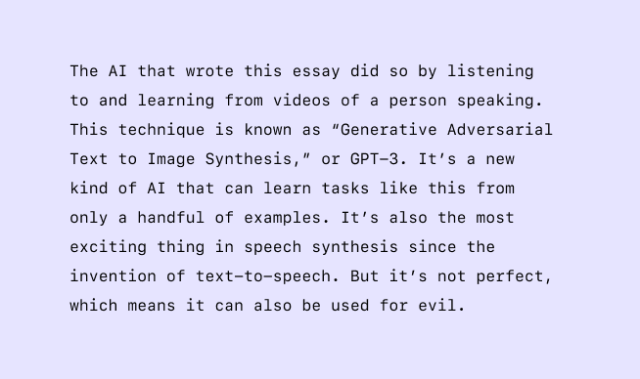Artificial intelligence written content, we’ve heard a lot about it.
But what exactly is AI-based GPT-3 all about?
What can it actually do? And should content writers now be afraid of GPT-3?
You’ll find the answers to all your questions in this blog post.
What is GPT-3?
GPT-3 is an autoregressive language model developed and launched by OpenAI. It is based on a massive neural network with 175 million synapses and can add and compose texts by itself under minimal specifications.
GPT-3 was launched in 2020. It is the largest Natural Language Processing Transformer (NLP) that can accurately and effectively reproduce human thought and reasoning patterns.
The generated texts are so well-written that the reader can no longer distinguish them from those written by humans.
This new technology generates an average of 4.5 million words a day and is used by more than 300+ AI copywriting tools.
How does GPT-3 work?

GPT-3 uses a neural network based on a deep learning model. It uses certain AI algorithms and existing content to create new content.
The AI looks for certain patterns and tries to draw conclusions from them, just like back in school. Remember? Teachers taught you theories, and you had to apply them to different tasks.
That’s basically how it works with GPT-3. The AI trains its algorithms by collecting data, drawing conclusions and applying them to new content.
As a result, it gets feedback and improves its algorithm. If the algorithm is good enough to draw conclusions, then the GPT-3 AI uses this knowledge for new data.
The important thing here is that the AI is constantly being “fed” with new and large data so that it can continue to grow and learn.
The fascinating thing is that this AI can even create custom content.
It does this by using information and interactions from individual customers, learning from it, and presenting new content targeted to the individual customer.
How many languages do GPT-3 support?
GPT-3 has been trained with a Western text corpus and does best with English and other languages like Spanish, German, Japanese, Chinese etc., but most programs are from the US and therefore most languages are simply translated from English.
What can you do with GPT-3?

GPT-3 can be your personal writing assistant, interpreter, programmer, author, journalist and poet, among other things.
What else can it do?
- Generates codes and understands your written codes
- Design beautiful website templates
- Shows you how to generate a JSX layout using simple language
- Generates regex
- Clone website using URL of that website
- Object use-case generation: you type an object (e.g. apple) and it tells you what you can do with it (peel, cut, cook, bake, purée)
- It can make diagrams and tables when commanded in simple language
- It can play games or evaluate things (e.g. Art pieces)
- Philosophize (e.g. look in the pictures below)
- Write machine learning models
- Generate formulas by describing the equation with simple words
- Create animations
- Create 3D scenes/objects
- Create good resumes
- Generate live sports tickers
How good is it really? Can GPT-3 AI be dangerous?

Ever heard of Liam Porr? Neither did I, but what he did with GPT-3 is astonishing! He used the new AI as an experiment that wrote entire blog posts.
That in itself is quite remarkable, but what came after is unbelievable: one of the posts got to be #1 on Hacker News and most readers didn’t even notice that it wasn’t written by a human copywriter, but by an AI.
There has been a lot of talk about GPT-3 and its capabilities — ridiculed by some, actively supported by some. But this blog by Liam Porr is proof of what AI is already capable of — writing content in a human way.
The same goes for an article from The Guardian titled “A robot wrote this whole article.
Are you scared yet, human?” which was written entirely by a GPT-3 based AI. Fascinating and scary at the same time, isn’t it?
Also, some people have been questioning whether humanity should be afraid of the AI now, but the AI just replies nonchalantly that it would not be the intention of it to wipe out humanity.
Today GPT-3 cannot destroy mankind yet, but we don’t know yet what will be possible in a few years.
Now we should be aware that AI can support us in many tasks and not take over our job completely. So you are still very irreplaceable!
Future prospects of GPT-3
OpenAI had already released GPT-2 in the year 2019 — the predecessor of GPT-3.
Back then it could already write texts well but was still far from being as good as human copywriters. Then came GPT-3, the largest human-like NPL transformer.
What will happen after GPT-3? Will GPT-4 and other series come in the future?
Nothing is certain, but considering how quickly GPT-3 was launched after GPT-2, you can be pretty sure that more will follow after GPT-3.
It is also certain that more companies will get a scent of GPT-3 based AI and use it to increase the productivity, creativity and efficiency of their marketing teams.
GPT-3 Based AI Content Tools
GPT-3 tools are the future of content creation. Here are the top 5 best GPT-3 AI content writing tools that you can try in 2022.
1) Jasper.ai is the best tool for creating content with GPT-3. Just enter your topic details and Jasper will generate a marketing copy for you. You can also save your data online for future use or reference. Try Jasper.ai For Free
2) Copy.Ai is a revolutionary AI-powered tool that makes content creation a breeze. Just provide it with some keywords and the name of your product, and it will generate a whole piece of content for you. Try Copy.ai For Free
3) Copysmith is an AI-based GPT-3 content generation tool that will help you drive growth with remarkable quality and speed. It is easy to use and helps you organize and store all of your content ideas. Try Copysmith.ai For Free
4) Writesonic is an AI-powered copywriting tool that can be used to create engaging content for websites and social media platforms. It integrates smoothly with social platforms like Twitter, Facebook, Instagram, and Google. Try Writesonic For Free
5) Copymatic has integrated GPT-3 into their own software and is using it to generate AI-generated subject lines that increase open rates. It can also help you to generate blog posts, articles, social media captions and more. Try Copymatic.ai For Free
AI Content Generated Examples By GPT-3 Tools
Check out the example of AI-generated content by these five GPT-3 tools.
1) Content generated by Copy AI Software.

2) Content Generated by Jasper AI Software.

3) Content Generated by Writesonic AI

4) Content Generated by Copysmith AI

GPT-3 Powers the Next Generation of Apps
Over 300 online applications are delivering GPT-3–powered search, conversation, text completion, and other advanced AI features through Open.ai’s API.
Leave a Reply